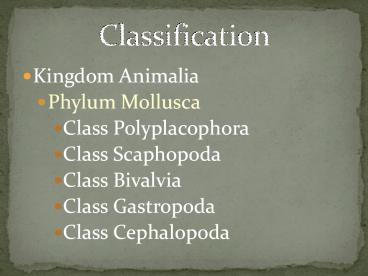Kingdom Animalia - PowerPoint PPT Presentation
1 / 19
Title:
Kingdom Animalia
Description:
Kingdom Animalia Phylum Mollusca Class Polyplacophora Class Scaphopoda Class Bivalvia Class Gastropoda Class Cephalopoda * * * * * * * Most diverse class in Phylum ... – PowerPoint PPT presentation
Number of Views:126
Avg rating:3.0/5.0
Title: Kingdom Animalia
1
Classification
- Kingdom Animalia
- Phylum Mollusca
- Class Polyplacophora
- Class Scaphopoda
- Class Bivalvia
- Class Gastropoda
- Class Cephalopoda
2
- Most diverse class in Phylum
- Some have shells, some dont
- Most shells are coiled, colored, and textured
- Torsion process visceral mass is turned
180-allows head to go into shell - 2-4 tentacles with eyes or sensory cells
- Operculum-trap door to shell
- Separate sexes external fertilization
- Trochophore larvae
3
- Modified radula pertaining
- to food source
- Herbivores, carnivores,
- detritovors, parasitism
- Uses
- Scrap
- Drill
- Dart
- Secrete poison
- Grasp
4
(No Transcript)
5
Class Bivalvia Clams, Mussels, Oysters
- Only class with out a radula
- 2 shells (valves)
- Umbo-oldest part of shell
- Strong abductor muscles keep it closed
- Most are filter feeders
- Foot is used to burrow
- The scallops use jet
- propulsion to move
- http//www.youtube.com/watch?ve6Qsm9F1G7oNR1
- http//www.youtube.com/watch?v_2iXHBuSIJYfeature
related
6
Bivalve Reproduction
- Separate sexes
- Hermaphroditic
- Release sperm and eggs into water
- Some species may brood taking sperm in through
the siphon - Trochophore larvae
- Males when young
- When get bigger turn into females
- Trochophore larvae
7
(No Transcript)
8
- Has 8 shell plates
- Protection and flexing abilities
- Can role into a ball
- Surrounded by a structure called a girdle
- Most live in intertidal zone
- Strong foot for adhesion
- Uses radula tipped with
- magnetite to eat algae
9
- Separate sexes
- Fertilization is external in the water column or
in the females mantle cavity - Disperse in plankton as trochophore larvae
- Free swimming
- Rings of cilia
- Settle on sea floor as juveniles
10
(No Transcript)
11
- Most live in deep sea
- Tubular shell with 2 open ends
- Heads burrow in sediments
- No gills mantle acts as gills
- Reproduction
- Separate sexes, some hermaphroditic
- 1 egg is released at a time
- External fertilization
- Trochophore Larvae
12
- Heads burrow in sediments
- Have tentacles surrounding
- the foot called captacula
- that latch onto food
- Radula breaks food into
- smaller pieces
13
(No Transcript)
14
Class Cephalopoda Octopus, Squid, Nautilus, and
Cuttlefish
- Most intelligent of all invertebrates , complex
nervous system - Muscular foot has been modified into a muscular
hydrostat moving items with no skeletal support
but instead with muscles (our tongues are an
example) - Found in all oceans at all depths
- Chromotophores colored
- pigments that allow them to change color or flash
light
15
Arms and tentacles
- Only squid and cuttlefish have retractable
tentacles for hunting - The arms may have suckers, hooks, or sticky palps
- Males have a special arm to deliver a sperm
packet to the female - Longest Mollusk
- Colossal Squid 46 feet
16
Vision
- complex camera-like eyes
- Camoflauge they use their chromatophores to
change brightness and pattern according to the
background they see - Ink
- All have ink sac but nautilus
- made of melanin (pigment)
- Confuses predator
- Mixes with mucus to make a cloud
17
Circulatory System
- Closed system
- 2 gill hearts
- 1 systemic heart
- Gills are very efficient because water is being
forced fast through the mantle - Gills are smaller than in other mollusk, but
because they are so efficient that is ok
18
Reproduction
- Separate sexes
- Usually includes courtship with color changes
- Most may die after spawning
- Males transfer a sperm packet to the female by
means of a penis or modified tentacle - The female then lays large egg clusters on the
sea floor - No Trochophore stage like other
mollusks-juveniles hatch out of eggs
19
http//video.nationalgeographic.com/video/player/a
nimals/index.html































